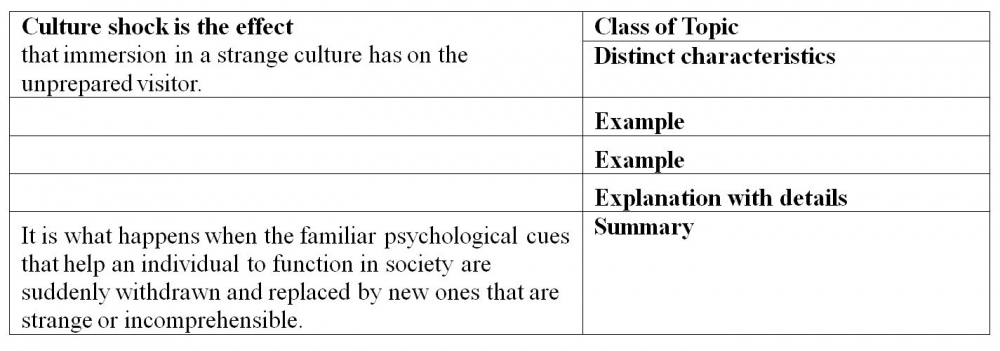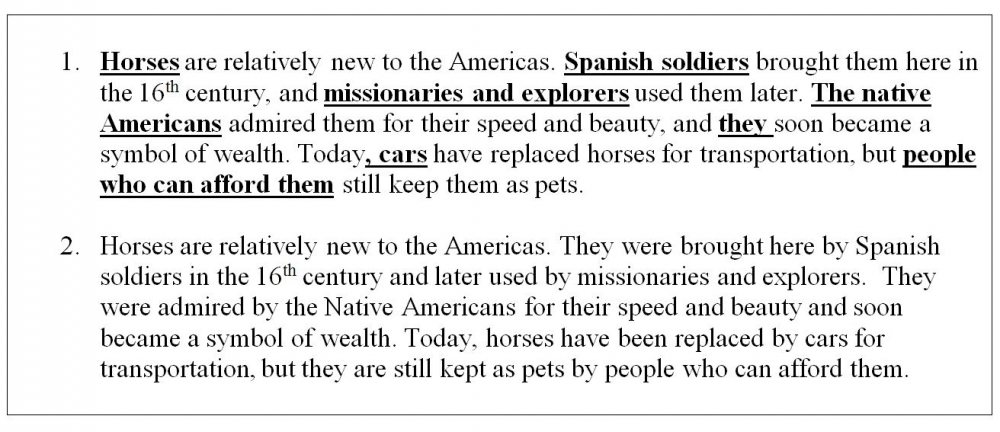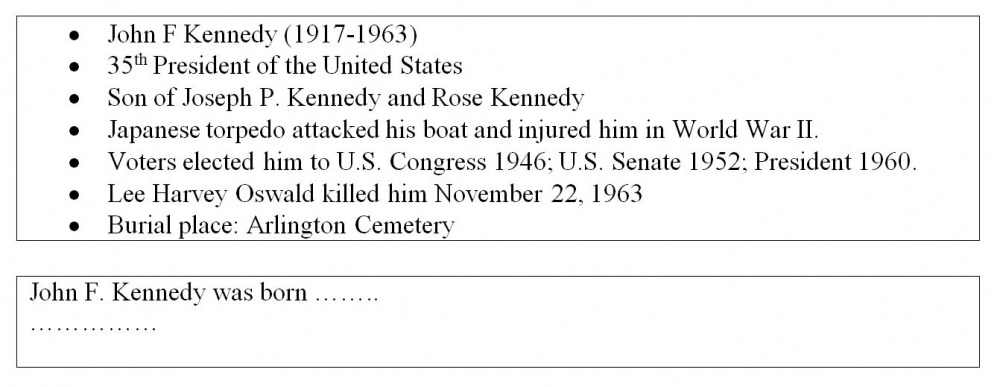|

Elizabeth O’Dowd |
|

Mahmoud Arani |
Author and Audience
If we examine the work of experienced writers, we see that it
involves systematic decisions, from the top-down level of organization
to the bottom-up level of word choice and sentence construction. These
decisions are driven by the author’s relationship with the intended
audience as, for example, in the following two “definitions”:
A: Culture Shock
Culture shock is the effect that immersion in a strange culture
has on the unprepared visitor. It is what happens when the familiar
psychological cues that help an individual to function in society are
suddenly withdrawn and replaced by new ones that are strange or
incomprehensible. (Toffler, 1970, p. 14)
B: Wife
I want a wife whom I can depend on; who will care for me when I
am sick and sympathize with my pain and loss of time from school. . . .
I want a wife who will not bother me with rambling complaints about
those duties which she naturally has to do. But I want a wife whom I can
tell when I feel the need to explain a rather difficult point that I
have come across in my course of studies. And I want a wife to whom I
can give my papers for typing after I have written them. (Syfers, 1971,
p. 56)
These texts address very different audiences. The first aims to
inform a relatively mature and educated reader who is not known to the
author. Accordingly, it shows the conventional construction for a formal
definition: a general classification of the concept, followed by
specific characteristics, and then clarifying details about the events
that make up culture shock. Sentence structures match these functions:
adjective clauses are custom-built for distinguishing characteristics
(“that immersion . . . has on the unprepared visitor”). Passive voice
and abstract vocabulary (immersion, psychological cues,
withdrawn) complete the academic tone.
The second text also addresses an educated, unknown audience,
but in order to amuse. Its success depends on reaching readers who would
find this definition of wife outrageous and
understand its satirical purpose. Written for a feminist magazine, the
shared joke is carefully constructed: Instead of a conventional
definition, we have a long list of assertions, expanded by
distinguishing adjective clauses with a repetitiveness that exaggerates
the blundering insensitivity of their meaning. The irony will not be
lost on female readers who may have heard themselves complaining about
such male insensitivity. The academic-sounding whom/to whom, as well as rather and naturally, is belied by
the consistent use of I (11 times in four
sentences), which suggests the self-seriousness of an oversized ego.
These examples illustrate how both writer and readers need to
co-construct the meaning of a text. In other words, readers must read like writers to interpret the author’s
intention, and authors must write like readers to
anticipate their audience’s response.
How can developing writers learn to do this, especially in a
nonnative language? The answer, we propose, is to bring reading and
writing together in the classroom in a conscious integration. The
reading stage involves text analysis of the type indicated earlier.
Through guided discussion, English learners can appreciate what kinds of
choices make a model text work. Next, through guided drafting in a
joint text construction activity (Derewianka, 1990), they can learn to
emulate those choices. This prepares writers for the final stage:
independent construction, where they approach their own writing with a
reader’s eyes. The rest of this article offers suggestions for the
three-stage learning cycle (Coffin et al., 2003), with an
intermediate-level class.
Stage 1: Text Analysis
Focusing on top-down logical organization, students are led to
notice how the culture shock definition is put together logically and
how it may be elaborated through examples and explanations. They might
label the functional parts in the text or, for more engagement,
reconstruct it by choosing and ordering components from the adapted
original, as in Exercise 1.
Exercise 1. Text Analysis: Culture Shock
Here is the definition paragraph that we studied last
week. Expand the paragraph by choosing the three best sentences from the
list below. Make sure your sentence matches the functions on the
right.

- Culture shock is generally not a pleasant experience.
- Peace Corps volunteers suffer from it.
- Culture shock is what happens when a traveler suddenly finds
himself in a place where yes can mean no, where laughter may signify
anger.
- The first stage of culture shock—the honeymoon period—is the easiest.
- Marco Polo probably suffered from it in Cathay.
(Key: Sentences 2, 5, 3 in that order)
Stage 2: Joint Construction
Having discussed and analyzed the author’s arrangement of ideas
for culture shock, students try making similar decisions themselves for
a text with a similar genre. In Exercise 2, sentence starters
provide a frame but leave content ideas wide open for students to
negotiate in this teacher-led cooperative activity. Thus, less confident
students contribute while listening to the reasoning of stronger
classmates, who are themselves scaffolded by the text they have just
analyzed.
Exercise 2: Joint Construction: Plagiarism
Draft a paragraph following the structure of our
“culture shock” definition. You may expand the paragraph with more
examples and details than you see in the chart.

Stage 3: Independent Construction
During Stages 1 and 2, students have learned rhetorical
concepts such as class and distinguishing characteristics. These will be
used as metalinguistic tools when they write their own definitions and
bring them back to the classroom to share so that peers can read like
writers for each other.
Exercise 3: Independent Construction
Write your own paragraph, defining a behavior or an
experience. Start with the class and the distinguishing characteristics. Use examples and
explanations with details to expand your paragraph. End with a summary.
Some ideas: Success, revolution, respect, addiction.
Bottom-Up Construction
The learning cycle also develops grammar in writing. Exercises
4–6 focus attention on how passive sentences contribute cohesion to a
text by keeping the topic consistently in subject position.
Exercise 4: Text Analysis: Horses in the New World
- Look at the Paragraph 1. The topic is horses. The
paragraph underlines every subject
(first idea) in each sentence. How many different ideas are
underlined?
- Now look at Paragraph 2. Underline the subjects.
How many different ideas are underlined?

Exercise 5: Joint Construction: JFK
Use these facts about President John F. Kennedy (JFK)
to write his biography. Keep JFK (“he” or “his ___”) as the first idea
in every sentence. Use passive voice where you need
to.

Exercise 6: Independent Construction
Write the biography of a famous person. Keep the
person (“she” or “her ___”) as the first idea in every sentence. Use
passive voice where you need to.
Conclusion
With exercises like these, the learning cycle helps students
become independent writers, by first becoming readers who appreciate
text construction at all levels— in
their own work and in the work of others.
REFERENCES:
Coffin, C., Curry, M. J., Goodman, S., Hewing, A., Lillis, T.
M., & Swann, J. (2003). Academic writing: A toolkit for
higher education. London, England: Routledge.
Derewianka, B. (1990). Exploring how texts
work. Rozelle, New South Wales, Australia: Primary English
Teaching Association.
Syfers, J. (1971). I want a wife. Ms., 1.
Toffler, A. (1970). Future shock. London, England: Random House.
Dr. Elizabeth O’Dowd directs the MATESOL program
at Saint Michael’s College. Her research interests include systemic
functional linguistics as applied to academic reading, writing, and
grammar; teacher collaboration and content-language integration for
English language learners; and World English.
Dr. Mahmoud T. Arani is the chair of the Applied
Linguistics Department at Saint Michael’s College. His general areas of
research interest are second language acquisition, teaching reading and
writing, and the application of discourse/error analysis in teaching
reading/writing and in developing communicative instructional
materials. | 
